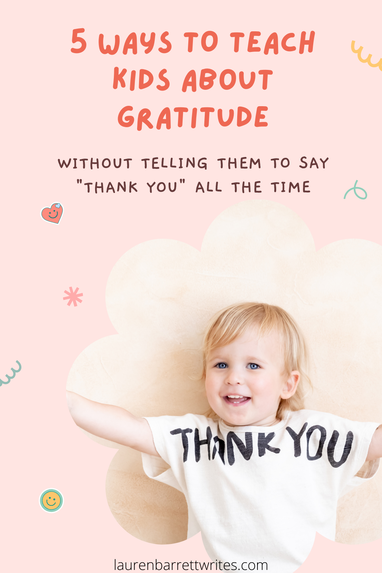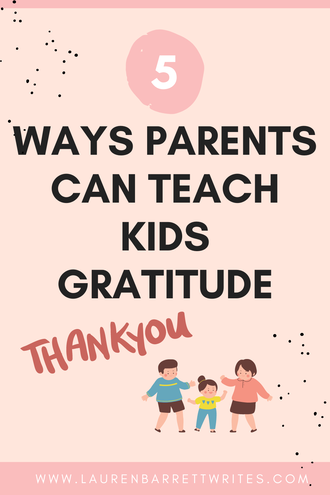|
Introduction
We are in the throes of the holiday season where our young kids are going to be getting a lot of things handed to them for free. Halloween candy, a home-cooked Thanksgiving meal, and Christmas presents. And nothing is worse than having our kids feel entitled to all of these things without any expression of gratitude. And while, as parents, we want our young kids to say thank you to all of their generous givers, we also want them to experience that warm feeling that swells inside of us when we truly practice gratitude. But that doesn’t come naturally to little kids, we actually have to help our kids practice gratitude. Luckily, I have 5 easy steps parents can do to propel gratitude along. Lauren Barrett Writes is a participant in the Amazon Services LLC Associates Program, an affiliate advertising program. As an Amazon Associate, I earn from qualifying purchases. Read more about these links in my disclosure policy.
Table of Contents
Parents Can Help Their Young Kids Practice Gratitude in 5 Easy Steps
#1. Stop Saying, “Say Thank You.”
I know, I know. I can see your faces all in shock at this one. Up until a few days ago, I was still doing this and then I learned why we shouldn’t, and I am doing my best to change this old habit. Dr. Becky from Good Inside says that gratitude is not a behavior we need to encourage but a feeling. Watch her video here on how she thinks about building gratitude in her kids. When we prompt our kids to say “thank you” over and over again, we are teaching them rote behavior without doing anything to encourage the feeling. Eventually, this forced action can lead to older kids simply forgetting, refusing, or defying their parents' old adage because they never learned how to feel gratitude. They simply think what is given to them is expected. I also just want to add that telling your kids to say “thank you” while also teaching them the feeling is OKAY and works.
#2. Notice Moments of Gratitude
Instead of telling our young kids to say “thank you,” Dr. Becky suggests stopping and pausing to notice moments of gratitude in your life. This could look like this in your household... Situation 1: You are all seated around the dinner table, eating a delicious meal. Pause. Say, “Hey everyone, do you know what I just noticed? We are all eating together as a family. This feels so nice. We have food. We are all laughing. I am so thankful for this.” Situation 2: You and your kid are out for a walk. Pause. Say, “Hey, let’s take a moment to just stop and look around. The fall leaves are so pretty. The sun feels so good on our skin. You have a jacket to keep you warm. You are having so much fun riding your bike, and the shoes you are wearing are really helping you pedal fast. I love moments spent with you like this. I’m so thankful.” Now, your kids are noticing those moments that feel good and begin to connect future experiences like these ones with a feeling of gratitude. Dr. Becky also cautions parents that now isn’t the time to lecture kids on how some kids don’t have all of these things. She states that over time the more kids notice our slowing down to acknowledge a good feeling, the more likely they will do the same in the future.
#3. Model Gratitude
Studies have found that grateful parents raise grateful children. That means you want them to catch you expressing gratitude. Whether it be saying thank you to your husband for cleaning up the kitchen or thanking the cashier at checkout, you want your child to notice your gratitude. I’m a big fan of thank you notes and a gratitude journal. Therefore, I definitely want my child to see my writing these notes and jotting in my journal. This can be simply done like this: Situation 1: At Target. Hmm, I’m looking at my list of what I need. Ohh, I need to get some thank you notes to write to all the people who gave you a gift at your birthday party. It was so nice of them to get you all those great gifts! You love playing with your new presents. Do you want to help me pick some out, and we can write them together at home? Situation 2: Before breakfast While you play before breakfast, I’m going to do part of my morning routine. I like to write down four things I am thankful for. Let’s see. I am thankful for...a,b,c, and d Your kids will pick up on all the ways you express gratitude and begin to practice what you do. Also, be sure to thank your children too!
#4. Practice Gratitude
Practicing gratitude with your kids is similar to modeling gratitude, but this time you are going to involve your kids in doing some of the work. Like most things we learn, practice helps build a skill. Here are three ways to practice gratitude with your kids. a.) Ask them questions: When you are stopping and pausing to notice gratitude, ask your kids how they feel in the moment too. Ask them what they are thankful for before bed. Ask them who they are thankful for each day. Your kids might not be able to answer right away, especially if they are still young. But just by asking and then pausing to allow them to answer is enough to start getting their wheels turning about gratitude. If they don’t answer after an appropriate wait time, help them out with a few options. We went to the park today. That was fun. Maybe you are thankful for that. You got to play with your trains at grandma’s house. You could be grateful for that. Before long, they will be answering on their own. b.) Write thank you letters Involve them in “writing” letters to people they are thankful for. These letters can be to family members, friends, teachers, and service members (firefighters, police officers, mail carriers, the military, etc). Explain why you are doing this, do it, and then send them out. c.) Use pretend play Use stuffed animals, toys, or imagination to practice gratitude. For example, pretend to have a birthday party for one of your kid’s stuffed animals. Bunny will open presents and practice saying thank you to his guests for his gifts even if he doesn’t like them. Also, you can have your kids practice trick-or-treating before Halloween and have them say thank you for getting candy. Planting seeds of kindness through make-believe will give your children the tools necessary to handle situations where they need to practice gratitude on their own.
#5 Point Out Gratitude
The last one is simple and summarizes everything up. Whenever you see gratitude in books, on TV, and in real life, point it out to your kids. That’s it.
Final Thoughts
Gratitude is so important, but it isn’t something you want to force upon your kids. Remember gratitude is more than a behavior. It’s a feeling we want kids to experience inside of them. This feeling is the way in which we will build long-lasting practices of gratitude with our kids that they will carry long into adulthood. The biggest takeaway is taking the time as a parent to pause and notice those feelings of gratitude with your kids. And before long, your heart will be melted as your kid says a sweet little thank you all on his own.
Sign up to my email list to get more tips on how to practice mindful parenting and build better relationships with your kids.
Want help for life’s hard moments? Check out my parenting guide, Now What? or sign up for my parenting checklists below.
0 Comments
Leave a Reply. |
Categories
All
|
Proudly powered by Weebly






 RSS Feed
RSS Feed